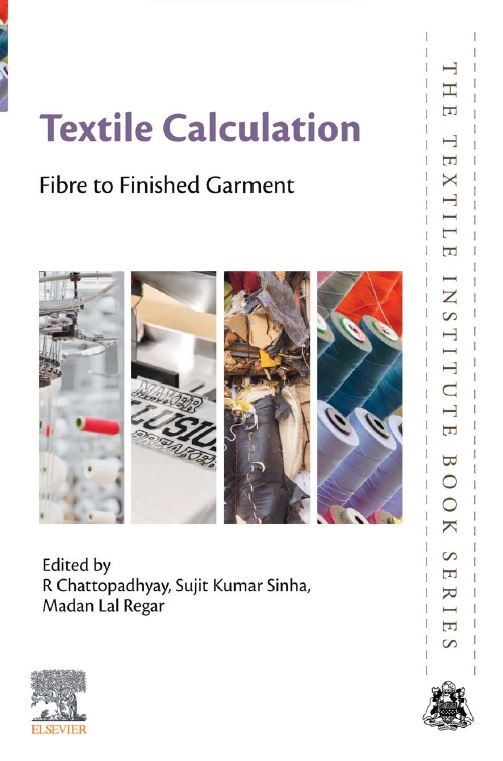Textile Calculation: Fibre to Finished Garment
By R. Chattopadhyay, Sujit Kumar Sinha and Madan Lal Regar

Contents:
List of contributors xi
1 Introduction: textile manufacturing process 1
Chattopadhyay, S.K. Sinha and Madan Lal Regar
1.1 Raw material and its characteristics 1
1.2 Expression of fineness 1
1.3 Importance of fiber properties 2
1.4 Ranking fiber properties for various spinning technologies 6
1.5 Estimation of fiber parameters from fiber linear density 7
1.6 Flow chart of spinning process 7
1.7 Flow chart of weaving process 10
1.8 Flow chart of weft knitting process 11
1.9 Garmenting process flow chart 11
2 Applications of selected response surface design of
experiments and advanced control charts in textile engineering 13
Subhankar Maity
2.1 Role of statistics for textile engineers 13
2.2 Design of experiment 15
2.3 Response surface design 16
2.4 Process control in textiles by advanced control chart 35
2.5 EWMA control charts 50
2.6 Conclusions 53
References 54
3 Man made fiber manufacturing process 57
Supriyo Chakraborty
3.1 Introduction 57
3.2 Degree of polymerization 57
3.3 Number average molecular weight, weight average, and
viscosity average molecular weight of polymers 59
3.4 Quantitative concepts of polymeric molecules for fibers 62
3.5 Relation between filament fineness (denier) and it’s diameter 63
3.6 Tensile strength of a filament 64
3.7 Temperature dependence of polymer viscosity 65
3.8 Melt spinning variables 67
3.9 Temperature profile of filaments in melt spinning 69
3.10 Determination of degree of crystallinity from DSC study 73
3.11 Determining crystallinity of the spun polymeric fibers 75
3.12 Conclusion 76
References 76
4 Prespinning processes (opening and cleaning, carding and drawing) 77
Chattopadhyay
4.1 Introduction 77
4.2 Opening and cleaning 77
4.3 Carding 90
4.4 Draw frame 97
Practice problems 106
5 Combing, roving preparation, and spinning 111
Chattopadhyay
5.1 Combing 111
5.2 Roving frame 120
5.3 Ring spinning 128
6 Yarn structure and mechanics 139
Chattopadhyay
6.1 Yarn fineness/count conversion 139
6.2 Yarn diameter 140
6.3 Number of fibers in yarn cross-section 141
6.4 Linear density of plied yarn 142
6.5 Torsion and bending of a fiber within twisted yarn 143
6.6 Yarn contraction/extension due to twisting/untwisting 143
6.7 Relationship between structural parameters 145
6.8 Packing coefficient 149
6.9 Close pack geometry 153
6.10 Fiber migration in spun yarn 155
6.11 Tensile behavior of twisted filament yarn 157
6.12 Radial pressure in twisted yarn 160
6.13 Wrap yarn 161
6.14 Blended yarn 162
6.15 Self-locking structure of spun yarn 166
6.16 Core sheath yarn 168
6.17 Exercise problems 169
References 170
7 Fabric preparatory 171
Akhtarul Islam Amjad and Madan Lal Regar
7.1 Introduction 171
7.2 Winding of yarn 171
7.3 Splicing 179
7.4 Production calculation of winding machine 179
7.5 Warping 181
7.6 Sizing 186
References 195
8 Woven fabric production 197
Akhtarul Islam Amjad, J.P. Singh and Madan Lal Regar
8.1 Introduction 197
8.2 Primary motions 197
8.3 Beat-up mechanism 203
8.4 Secondary motions 207
8.5 Auxiliary or stop-motions 210
8.6 Nonconventional weaving machine 210
8.7 Conclusion 214
References 214
9 Woven fabric structure 215
Biswapati Chatterjee
9.1 Introduction 215
References 236
10 Knitted fabric production 237
Roopam Chauhan and Subrata Ghosh
10.1 Introduction 237
10.2 Some basic terminologies and their relevant mathematical
equations 237
10.3 Geometry of loop and loop length 240
10.4 Robbing back 242
10.5 State of relaxation 243
10.6 Fabric areal density 244
10.7 Tightness factor 245
10.8 Productions calculations 245
10.9 Warp knitting calculations 246
References 253
11 Calculations in fabric chemical processing 255
Chet Ram Meena and Janmay Singh Hada
11.1 Introduction 255
11.2 Calculations at various stage of textiles processing 255
11.3 Cuprammonium fluidity 259
11.4 Mercerization 260
11.5 Barium activity number 260
11.6 Dyeing 260
11.7 Conclusion 273
References 273
12 Apparel manufacturing measures and calculations 275
Manoj Tiwari and Prabir Jana
12.1 Introduction 275
12.2 Plant set-up and facility designerelated measures and calculation 276
12.3 Manufacturing operationserelated measures and calculations 284
12.4 Conclusion 298
References 298
13 Fiber testing 301
Madan Lal Regar, Chet Ram Meena and Janmay Singh Hada
13.1 Introduction 301
13.2 Standard conditions for yarn testing 301
13.3 Statistical averages 301
13.4 Humidity 305
13.5 Fiber length 307
13.6 Fiber fineness 310
13.7 Fiber maturity 316
13.8 Fiber quality index 318
13.9 Spinning consistency index 319
13.10 Tensile property 320
13.11 Nep count 323
13.12 Fiber crimp 323
13.13 Conclusion 324
References 324
14 Yarn testing 325
Vijay Goud, Apurba Das and Alagirusamy Ramasamy
14.1 Yarn linear density 325
14.2 Moisture in yarn 328
14.3 Yarn twist 331
14.4 Tensile properties of yarns 333
14.5 Evenness of yarn 339
14.6 Conclusion 348
Further reading 348
15 Fabric testing 349
Chet Ram Meena, Janmay Singh Hada, Madan Lal Regar and
Akhtarul Islam Amjad
15.1 Introduction 349
15.2 Major testing standards for textile testing 349
15.3 Gram per square meter 350
15.4 4-Point system 351
15.5 Strength of the fabric 352
15.6 Fabric handle 355
15.7 Thickness 360
15.8 Clothing science and comfort 361
15.9 Flame-retardant 365
15.10 Measurement of color strength 366
15.11 Dimensional change 367
15.12 Conclusion 368
References 368
Index 369
